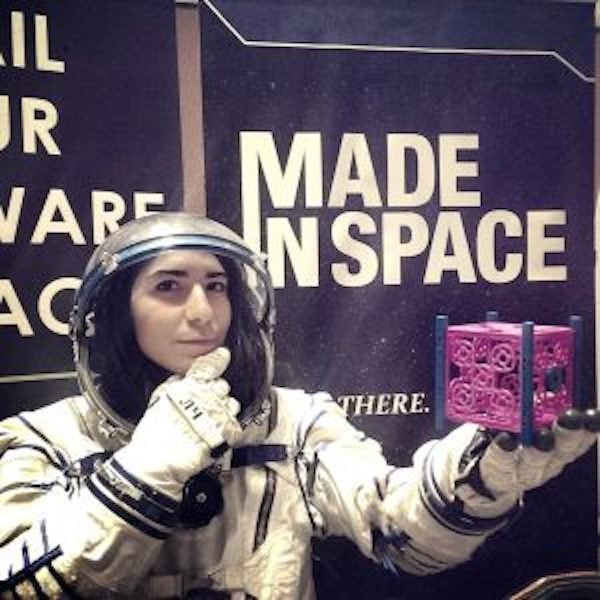
This article originates from Women In 3D Printing and is part of our effort to support the use of 3D printing technology by women. The article is re-published with permission.
Until a few days ago, Hasti was part of the Business Development unit at Made in Space. You may know Made In space as the company who sent a 3D printer in the SPACE!
Nora Toure: A 3D printer in a zero-G environment… how does that work?
Hasti Afsarifard: Initially, Made In Space planned to send an off-the-shelf 3D printer to the International Space Station, but quickly realized there were several challenges that would require building a specialized 3D printer from the ground up. The printer was ruggedized to survive the intense loads and vibrations experienced during a rocket launch. There were also specific adjustments that had to be made to ensure that components inside the printer won’t float around in zero-G and that prints adhere to the print bed. The printer also needs to be safe, easy-to-use and capable of being operated remotely.
Nora Toure: As you are working on getting your second 3D printer in Space, I’d like to understand: why sending 3D Printers in Space?
Hasti Afsarifard: The ISS is currently crowded with an abundance of spare parts that will most likely never be used but kept in store in preparation for anticipated scenarios.
Nora Toure: What type of models are being printed in space?
Hasti Afsarifard: The first object printed in space was a replacement part for the Zero-G Printer itself and the most recent print was a functional ratchet that was printed on-demand. Most of the other objects printed on ISS so far are test coupons that were recently brought to Earth to be compared with identical objects to determine if there are any differences in objects made in space with object made on Earth. You can download the models of the first objects 3D printed in space for free on our Sketchfab page.
Nora Toure: Is there a program for people to submit models to be printed into the space?
Hasti Afsarifard: You can submit ideas through our beta print request form (http://www.madeinspace.us/print-request-form) or email business@madeinspace.us.
Nora Toure: How do you select those models?
Hasti Afsarifard: For the initial set of commercial prints we are interested in working with a variety of entities such as universities, space agencies, corporations and entrepreneurs to develop a variety of use cases that demonstrate unique values of utilizing additive manufacturing in space. For example, optimized structures that could only be created in weightlessness or iterating an experiment in a matter of days rather than months or years.
Nora Toure: I assume NASA and Space-related companies to be mostly male-dominant. You are actually working in such a company, do you confirm my assumption? If so, are you noticing some changes in this trend though?
Hasti Afsarifard: I think we’ve come a long way compared to where women were just a few decades ago. I often notice I’m the only woman in a meeting or one of the only women exhibiting at a space or 3D printing conference but I don’t let that intimidate me. It’s actually empowering. I know that I bring a unique perspective and set of skills to my team. Although workforce ratios are far from balanced, women are more ambitious these days and I’m optimistic that it will balance out in time.
Nora Toure: Prior to your position at Made In Space, you already had an extended experience with 3D Printing. Where does this interest for 3D Printing come from?
Hasti Afsarifard: My interest in 3D printing was ignited in Fall of 2012 when I was sitting in my Management of Technology and Innovation class at UC Santa Cruz trying to come up with a startup concept to develop for my quarter-long project. I wondered what the world would be like if everyone had access to this technology and I dove into researching this industry. After that class I found creative ways to keep researching and learning about 3D printing. I volunteered at a local tech-center known as MakersFactory, I took an art class focused on using digital fabrication technologies, and I joined an engineering club on campus then helped assemble and demonstrate the first 3D printer that was accessible to all students and faculty at UCSC.
Nora Toure: How would you like to see the 3D Printing industry evolve in the future?
Hasti Afsarifard: Ever since my initial fascination with 3D printing I have aspired to make on-demand manufacturing accessible to everyone. I don’t see it in everyone’s homes any time soon, but it’s quickly becoming available at libraries, schools, print service providers, and online service providers. There are several challenges with consumer printers, such as speed and ease-of-use, that need to be solved before mass adoption can become a reality.
Thank you Hasti for your involvement with Women in 3D Printing!
Want to know more? Check out this video where Hasti explains some of the things they’ve printed in space and what’s next: https://youtu.be/AxVnn3posuY
And don’t forget to join the Women in 3D Printing group on LinkedIn, click here to join!

